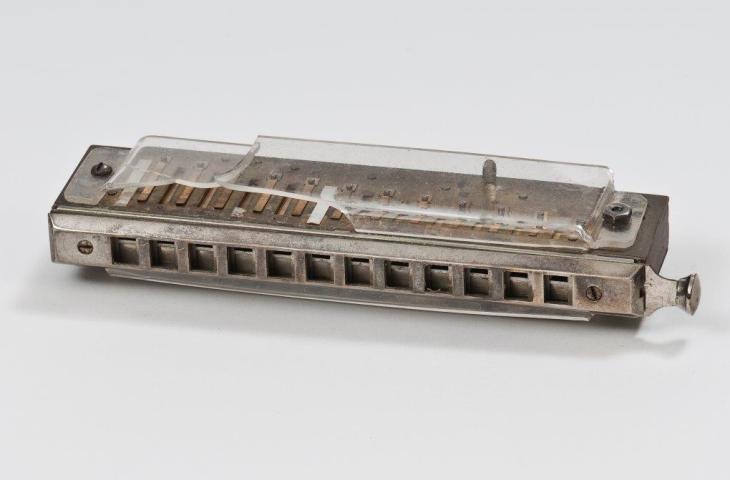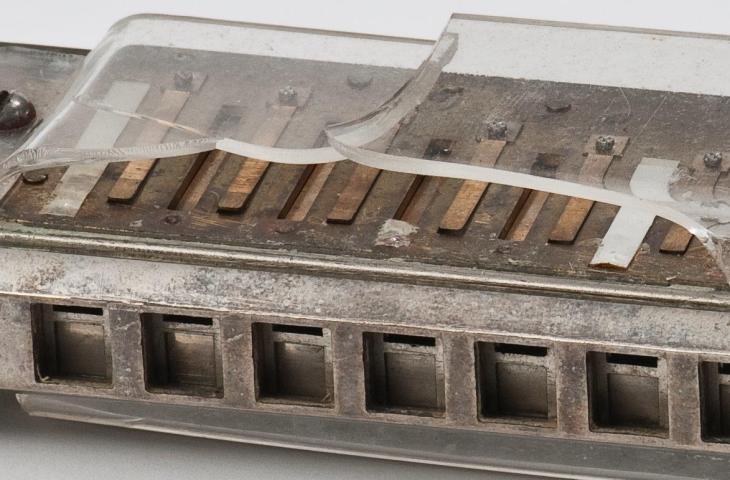April 2022
Fig.1

Harmonica, Hohner, Trossingen, before 2000, inv. 2017.0019.011
Fig.2

Harmonica, Hohner, Trossingen, before 2000, inv. 2017.0019.011
Toots Thielemans honoured at the KBR
This April, the exhibition ‘Toots 100: The Sound of a Belgian Legend’ opens at the Royal Library (KBR), just a few steps from the MIM. Resulting from a collaboration between KBR and the Royal Museums of Art and History via the MIM, the exhibition is full of sounds and documents that trace the phenomenal career of the greatest jazz harmonica player, Toots Thielemans (1922-2016). Several instruments from the MIM collections are included in the exhibition, but many others can still be discovered in the museum - such as this special harmonica that once belonged to Toots.
How the harmonica works and its types
The harmonica is a wind instrument with free reeds. These thin metal plates, called reeds, vibrate freely on either side of their axis. In the harmonica, the reeds begin to oscillate when air flows through them, driven by the player’s breath.
The first harmonicas appeared in Vienna in 1825, before spreading across Europe, the United States, and the rest of the world. Initially handmade, production later became industrial, reaching around 50 million units annually by the mid-1920s. One of the main producers was the German company Hohner, founded in Trossingen in 1857, which popularised this small, inexpensive instrument that you can easily carry anywhere.
There are two main types of harmonicas: diatonic and chromatic. To make an easy comparison, the diatonic is limited to the white keys on a piano, while the chromatic can play all the notes, semitone by semitone. Inside its protective cover plates, the chromatic harmonica contains the components of two diatonic harmonicas tuned a semitone apart. Thanks to a small lever on the side, called a slide, the player can select which harmonica to play, giving access to all the notes of the scale. Clever!
The standard chromatic harmonica has 12 round or square holes and a range of three octaves. Each hole contains four reeds - two playable without the slide, and two requiring the slide - whether the notes are blown or drawn in by the player. That makes 48 vibrating reeds in total.
Toots Thielemans’s harmonica
Toots Thielemans always played on chromatic harmonicas made by Hohner, especially the Chromonica model, the brand’s flagship series. Launched in 1925, the Chromonica is also the best-selling chromatic harmonica worldwide. The specimen shown here has a wooden comb, brass reed plates and reeds, and Plexiglas cover plates that allow you to see the reed plates and reeds inside. All reeds are hand-tuned before leaving the factory and require periodic maintenance and re-tuning.
Hohner also produced two jazz-oriented chromatic harmonicas endorsed by Toots, based on the Chromonica: the Toots Hard Bopper, with a powerful sound, and the Toots Mellow Tone, with a warmer tone. These are on display at the KBR exhibition!
Text: Géry Dumoulin